Miscellaneous business activities dominates the sector
· Preliminary results of the 2006 Census of Philippine Business and Industry reported that the Philippines had a total of 1,516 establishments with average total employment (ATE) of 20 and over engaged in Real Estate, Renting and Business Activities.
· About eight out of ten (79.4%) were engaged in Miscellaneous business activities like legal, accounting, bookkeeping activities; market research; business and management consultancy; architectural and engineering; advertising; labor recruitment; investigation and security activities; photographic activities; call center activities; medical transcription activities and other business activities. Computer and related activities ranked second with 9.7 percent and Real estate activities, third with 8.8 percent. On the other hand, Research and development recorded the lowest number. Figure 1 shows the distribution of Real Estate, Renting and Business Activities establishments with ATE of 20 and over by industry division.

Most establishments are in the National Capital Region (NCR)
· On the regional level, the NCR had the most number of establishments with 71.7 percent. Central Visayas and CALABARZON placed second and third with 6.2 percent and 5.2 percent, respectively. Cagayan Valley had the least number.
Miscellaneous business activities employs the biggest number of workers
· The sector employed a total of 357,614 workers in 2006. Of the total, almost all were paid employees and the rest were working owners or unpaid workers.
· Having the most number of establishments, Miscellaneous business activities, likewise employed the biggest number of workers with 89.1 percent. Computer and related activities and Real estate activities followed next with 7.3 percent and 2.9 percent, respectively. In contrast, Research and development recorded the least with less than one percent.
· Region wise, the NCR recorded the biggest share in employment comprising almost three-fourths (74.1%) of the total workforce. Central Visayas placed second with 9.3 percent and CALABARZON third, with 4.4 percent. Cagayan Valley registered the least.
Workers involved in research and development are the highest-paid employees
· In 2006, the sector paid a total compensation of PhP67.4 billion, equivalent to an average annual compensation of PhP188,953 per paid employee. About 94.9 percent (PhP64 billion) of the total was spent for gross salaries and wages and the remaining 5.1 percent (PhP3.4 billion), for employers contribution to SSS/GSIS and the like.
· Industry wise, Miscellaneous business activities paid the highest compensation of PhP56.4 billion comprising more than four-fifths (83.6%) of the total. Computer and related activities placed second with PhP7.8 billion or 11.5 percent. Real estate activities ranked third with PhP2.7 billion or 4 percent. On the other hand, Renting of machinery and equipment without operator; personal and household goods recorded the lowest amount of Ph169 million or 0.3 percent.
· Among regions, the NCR spent the biggest share in compensation amounting to PhP57.4 billion (85.1%). Central Visayas and CALABARZON were in second and third place with PhP4.4 billion (6.5%) and PhP2.3 billion (3.4%), respectively. On the contrary, the Cagayan Valley Region paid the least with PhP27.5 million (0.04%).
· Workers involved in Research and development were the highest-paid employees receiving an average of PhP362,352 per annum. Employees of Computer and related activities and Real estate activities followed next with PhP296,601 and PhP262,198; respectively. However, those involved in Renting of machinery and equipment without operator; personal and household goods received the lowest annual pay of PhP124,508. Figure 2 shows the average annual compensation per paid employee by industry division.
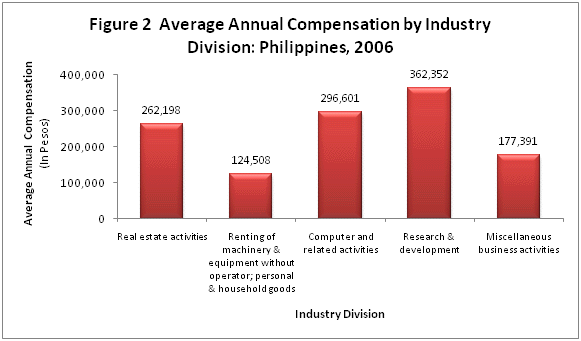
· Employees working in the National Capital Region received the highest average annual compensation of PhP217,094 while those employed in Zamboanga Peinsula received the lowest with PhP29,568. Figure 3 shows the average annual compensation per paid employee by region.
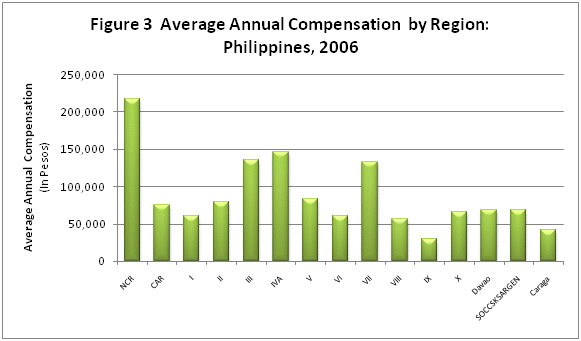
Miscellaneous business activities and real estate activities contribute the biggest share in revenue and costs
· Gross revenue generated by the sector reached PhP189.8 billion in 2006. Miscellaneous business activities contributed the biggest share with PhP112.6 billion representing almost three-fifths (59.3%) of the total. Real estate activities came next with PhP55.5 billion (29.3%). On the other hand, Renting of machinery and equipment without operator; personal and household goods shared the least with PhP1.3 billion (0.7%).
· Total costs (excluding compensation paid to employees) amounted to PhP83.2 billion in 2006. Being the major contributors in revenue, Real estate activities and Miscellaneous business activities also had the largest proportion in costs with PhP36.1 billion (43.4%) and PhP36 billion (43.3%), respectively. However, Research and development incurred the lowest cost of PhP721.7 million (0.9%). Figure 4 shows the revenue generated and costs incurred by the Real Estate, Renting and Business Activities sector by industry division.
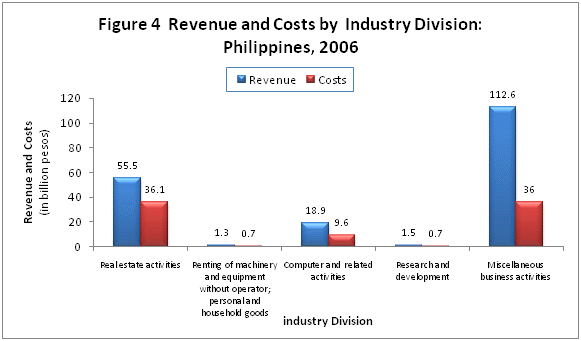
Revenue per peso cost is estimated at PhP2.28
· Revenue per peso cost was estimated at PhP2.28 which means that for every peso spent, PhP2.28 was earned by the Real Estate, Renting and Business Activities sector.
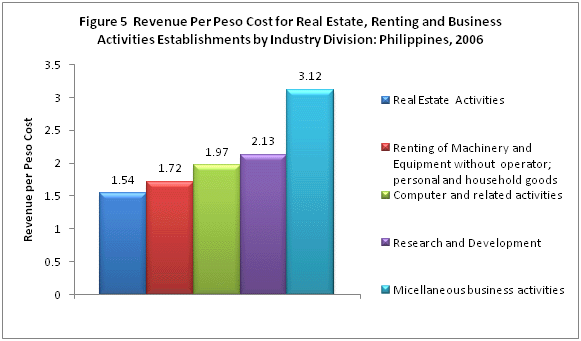
· The highest revenue per peso cost was recorded in Miscellaneous business activities at PhP3.12; while the lowest, in Real estate activities at PhP1.54. Figure 5 shows the revenue per peso cost by industry division.
Value added totals to PhP119.7 billion
· Value added derived by Real Estate, Renting and Business Activities sector totaled to PhP119.7 billion in 2006.
· Industry wise, Miscellaneous business activities registered the highest value added with PhP83.9 billion (70.1%) while Renting of machinery and equipment without operator; personal and household goods recorded the least with PhP760.6 million (0.6%). Figure 6 shows the value added derived by Real Estate, Renting and Business Activities establishments by industry division.
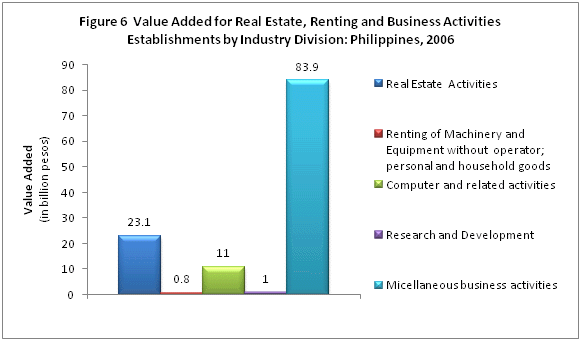
Real estate activities has the highest labor productivity
· Revenue per employee, a measure of labor productivity, was valued at PhP530,818 in 2006. Among the industry divisions, Real estate activities had the highest labor productivity at PhP5.4 million while Miscellaneous business activities, the least at PhP353.5 thousand.
· Value added per employee, another measure of labor productivity, was estimated at PhP334,705. Again Real estate activities topped the sector with PhP2.2 million while Miscellaneous business activities remained at the bottom line with PhP263,497.
Total change in inventories results to a negative value of PhP2.2 billion
· Total change in inventories (ending less beginning inventory) resulted to a negative value of PhP2.2 billion in 2006. All industry divisions except Computer and related activities and Miscellaneous business activities recorded negative values of change in inventories.
Gross addition to fixed assets reaches PhP9.1 billion
· Gross addition to fixed assets (capital expenditures less sale of fixed assets) acquired by the sector reached PhP9.1 billion in 2006.
· Miscellaneous business activities and Real estate activities recorded the biggest gross addition to fixed assets with PhP6.8 billion (75%) and PhP1.1 billion (12.2%), respectively. On the contrary, Renting of machinery and equipment without operator; personal and household goods acquired the smallest with PhP101.2 million (1.1%).
Total subsidies received from the government amounts to PhP168.7 million
· Total subsidies received from the government amounted to PhP168.7 million in 2006.
· Computer and related activities received the greatest amount of subsidies with PhP91.2 million (54.1%). However, no subsidy was granted to establishments involved in research and development.
TECHNICAL NOTES
Introduction
An economic census is a comprehensive collection, compilation, evaluation, analysis and publication of data about the economic activities of the country. It is a source of information for establishing a benchmark level for the measurement and comparison of national, regional and provincial economic growth. Particularly, the economic census data will be used in constructing national and regional income accounts in the country, in determining and comparing regional economic structures, in formulating plans and policies of the government in the attainment of economic goals, in providing updates for the frame of establishments and in the conduct of market research and feasibility studies.
The 2006 Census of Philippine Business and Industry (CPBI) is one of the designated statistical activities undertaken by the National Statistics Office. The 2006 CPBI is the 14th in the series of economic censuses conducted in the Philippines. It is preceded by those for 2000, 1994, 1988, 1983, 1978, 1975, 1972, 1967, 1961, 1948, 1939, 1918 and 1903. The present name, Census of Philippine Business and Industry was first used in the 2000 round with 1999 as the reference period.
Legal Authority
The conduct of the 2006 CPBI was governed by authority of the following legislative acts and presidential directives, namely:
* Commonwealth Act No. 591 (An Act to Create a Bureau of the Census and statistics, to Consolidate Statistical Activities of the Government Therein) approved on August 19, 1940. CA No. 591 empowers the Bureau, among other things, to prepare for and undertake all censuses of population, agriculture, industry and commerce. The same act also provides penalty for persons who fail to accomplish Census forms.
* Presidential Decree No. 418 dated March 20, 1974 - Reconstituting the Bureau of Census and Statistics to be known as the National Census and Statistics Office under the administrative supervision of the National Economic and Development Authority.
* Executive Order No. 121 - Reorganization Act of the Philippine Statistical System, dated August 4, 1987 renaming the NCSO to the National Statistics Office which shall be the major statistical agency responsible for generating general purpose statistics.
* Executive Order No. 352 - Designation of Statistical Activities that will generate critical data for decision-making of the Government and Private Sector signed on July 1, 1996.
* Executive Order No. 5 dated July 29, 1998 - Strengthening the National Statistics Office.
Scope and Coverage
The 2006 CPBI covered establishments engaged in 14 economic sectors classified under the amended 1994 Philippine Standard Industrial classification (PSIC) namely:
- A - Agriculture, Hunting and Forestry
- B - Fishing
- C - Mining and Quarrying
- D - Manufacturing
- E - Electricity, Gas and Water Supply
- F - Construction
- G - Wholesale and Retail Trade, Repair and Maintenance of Motor Vehicles, Motorcycles, and Personal and Household Goods
- H - Hotels and Restaurants
- I - Transportation, Storage and Communications
- J - Financial Intermediation
- K - Real Estate, Renting and Business Activities
- M - Private Education
- N - Health and Social Work
- O - Other Community, Social and Personal Service Activities
The following major divisions are excluded from the scope of the survey: L (Public Administration and Defense; Compulsory Social Security), P (Private Households with Employed Persons) and Q (Extra-Territorial Organization and Bodies).
The scope of the 2006 CPBI was confined to the "formal sector" only consisting of the following:
- Corporations and partnership
- Cooperatives and foundations
- Single proprietorships with employment of 10 or more
- Single proprietorships with branches
Unit of Enumeration
Like all other establishment surveys conducted by the NSO, the 2006 CPBI used establishment as the unit of enumeration. It is defined as "an economic unit under a single ownership or control, i.e. under a single legal entity, engaged in one or predominantly one kind of economic activity at a single fixed location". In actual practice, however, there are difficulties in applying the definition of an establishment. Thus, it is defined in operational terms to take into account the organization and record-keeping practices of establishments by making the single location and activity criteria more flexible. This necessitates the use of the kind-of-activity unit for certain sectors as the single location restriction is eliminated.
For Construction, Transportation, storage and communications, Insurance, Real estate buying, developing, subdividing and selling, and Investigation and security activities, the establishment is defined in operational terms as "the unit that is engaged in the production of the most homogeneous group of goods and services, usually at one location, but sometimes over a wider area, for which separate records are available that can provide data concerning production of these goods and services and the materials, labor and physical resources used in this production".
Classification of Establishments
Before the actual selection of samples, the establishments listed in the frame were classified based on economic organization (EO), legal organization (LO), industrial classification, employment size, and geographic location.
Economic organization refers to the organizational structure or role of the establishment in the organization. The following are the types of economic organization:
- Single establishment is an establishment which has neither branch nor main office
- Branch only is an establishment which has a separate main office located elsewhere
- Establishment and main office, both located in the same address and with branches elsewhere
- Main office only is the unit which controls, supervises and directs one or more establishments of an enterprise
- Ancillary unit other than main office is the unit that operates primarily or exclusively for a related establishment or group of related establishments or its parent establishment and provide goods or services that support but do not become part of the output of those establishments
The legal organization provides the legal basis for ownership of the establishment. The following are the types of legal organization:
- Single Proprietorship refers to a business establishment organized, owned, and managed by one person, who alone assumes the risk of the business enterprise. The establishment name is that of a person, or it has words such as Owner, Proprietor or Operator.
- Partnership refers to an association of two or more individuals for the conduct of a business enterprise based upon an agreement or contract between or among them to contribute money, property or industry into a common fund with the intention of dividing profits among themselves. The establishment name includes words such as Owners, Partners, Limited or LTD., Associates or ASSOCS.
- Government Corporation is a private corporation organized for private aim, benefit or purpose and owned and controlled by the government. The establishment name included words such as Corporation or CORP., INCORPORATED or INC.
- Private Corporation is a corporation organized by private persons. The establishment name includes words such Corporation or Corp, Incorporated or INC.
- Cooperative - the establishment name includes words such as Cooperative or COOP
The industrial classification of an economic unit is determined by the activity from which it derives its major income or revenue. The amended 1994 PSIC is utilized to classify units according to their economic activities.
The amended 1994 PSIC consists of an alpha character and 5 numeric digits. The alpha character, which represents the major division, is denoted by the characters A to Q. The first two numeric digits represent the division; the first three numeric digits, the group; the first four digits, the class; and the 5 digits, the sub-class.
The size of the establishment is determined by its average total employment (ATE). The following are the employment size classification used in the 2006 CPBI:
|
|
The geographic or physical location of the establishments was classified in accordance with the Philippine Standard Geographic Code (PSGC) as of December 30, 2006 which contains the latest updates on the number of regions, provinces, cities, municipalities and barangays in the Philippines.
The geographic domains of the 2006 CPBI for establishments with average total employment (ATE) of 20 and over are the provinces, independent component cities, chartered cities and highly urbanized cities and municipalities. On the other hand, the geographic domains for establishments with ATE of less than 20 are the regions.
Hence, the samples of the 2006 CPBI with ATE 20 and over shall provide data for 17 administrative regions, 81 provinces, 39 cities and municipalities. For samples with ATE less than 20, the data that will be presented up to the regional level only.
Frame
The 2006 List of Establishments (LE) was used as the frame for the 2006 CPBI. The 2006 LE was based on the combined results of the following:
- 2004 ULE conducted in NCR and selected urban barangays
- 2005 ULE in rural barangays in provincial capitals/cities/municipalities
- Supplemental lists from other sources
Sampling Design
The 2006 CPBI used stratified systematic sampling with a random start. For establishments with ATE 20 and over, the geographic domain (provinces, independent component cities, chartered cities and highly urbanized cities and municipalities) and the industry domain (5-digit or group of 5-digit PSIC and/or 4-digit or group of 4-digit PSIC) served as the first stratification variable. On the other hand, for establishments with ATE less than 20, the geographic domains are the regions and the industry domain, the industry groups. Employment size (ATE) was used as the second stratification variable.
Sample Size
The sample size of the 2006 CPBI was 57,404 establishments broken down by ATE of 20 and over (26,448) and ATE of less than 20 (30,956).
Response Rate
The overall response rate for ATE of 20 and over is 95.3 percent or 2,027 out of 2,128. These include receipts of "good" questionnaires, partially accomplished questionnaires, reports of closed, moved out or out of scope establishments. However, the effective response rate is 71.2 percent.
CONCEPTS AND DEFINITIONS OF TERMS
Economic activity or business is the activity of the establishment as classified under the amended 1994 Philippine Standard Industrial Classification (PSIC). Generally, the main activity of the establishment is the establishment's principal source of income. If the establishment is engaged in several activities, its main activity is that which earns the biggest income or revenue.
Employment is the number of persons who worked in or for this establishment as of November 15, 2006.
Average total employment is the sum of the number of persons who worked in or for this establishment for all months of the year divided by 12, regardless of the number of months the establishment is in operation.
Paid employees are all persons working in the establishment and receiving pay, as well as those working away from the establishment paid by and under the control of the establishment. Included are all employees on sick leave, paid vacation or holiday. Excluded are consultants, home workers, workers receiving pure commissions only, and workers on indefinite leave.
Salaries and wages are payments in cash or in kind to all employees, prior to deductions for employees contributions to SSS/GSIS, withholding tax, etc. Included are total basic pay, overtime pay, and other benefits.
Revenue is the value of goods, products/by-products sold and/or services rendered to others whether paid in cash or is considered receivable by the establishment. Valuation of products/by products sold should be in producers price (ex-establishment), net of discounts and allowances, including duties and charges but excluding subsidies. It also include goods transferred and/or services rendered to other establishment belonging to the same enterprise as the said establishment which should be treated as sales or as if sold to a customer; and revenue from products on a contractual basis from materials supplied by the establishment.
Costs refer to all expenses (excluding compensation) incurred during the year whether paid or payable. Valuation should be at market price including taxes and other charges, net of discounts, rebates, returns and allowances. Goods received from and services rendered by other establishment of the same enterprise are valued as though purchased.
Value added is gross output less intermediate costs.
Gross output (for Real estate activities with own or leased property ) is equal to the sum of total revenue, capital expenditures of fixed assets produced on own account, and change in inventory of real estate for sale; less cost of real estate purchased for sale.
Gross output (for Real estate activities on a fee or contract basis, Renting of machinery and equipment without operator; personal and household goods, Computer and related activities, Research and development and Miscellaneous business activities ) is equal to the sum of total revenue and capital expenditures of fixed assets produced on own account.
Intermediate costs is equal to the sum of the following cost items: materials and supplies purchased; fuels purchased to run motor vehicles, machinery and other equipments; electricity purchased; industrial services done by others; non-industrial services done by others; computer software expenses; research and experimental development and other costs (plus change in inventory of materials, supplies and fuels).
Fixed assets are physical assets expected to have productive life of more than one year and intended for use and/or being used by the establishment. Included are land, buildings, other structures and land improvements, transport equipment, fixtures, machinery, tool, furniture, office equipment and other fixed assets.
Gross addition to fixed assets is the sum of costs of new and used fixed assets acquired during the year, cost of alteration and improvements done by others and cost of fixed assets produced by the establishment less the value of sales of fixed assets during the year.
Book value of fixed assets is the initial value or acquisition cost of fixed assets less the accumulated depreciation.
Inventories refer to the stocks of goods owned by and under the control of the establishment as of a fixed date, regardless of where the stocks are located. Valuation should be at current replacement cost in purchasers price at the indicated dates. Replacement cost is the cost of an item in terms of its present price rather than its original price.
Change in Inventories is equivalent to the total value of inventories at the end of the year less the value at the beginning of the year.
Subsidies are special grants in the form of financial assistance or tax exemption or tax privilege given by the government to aid and develop an industry or production and to protect it against competition.
Source: National Statistics Office
Manila, Philippines
